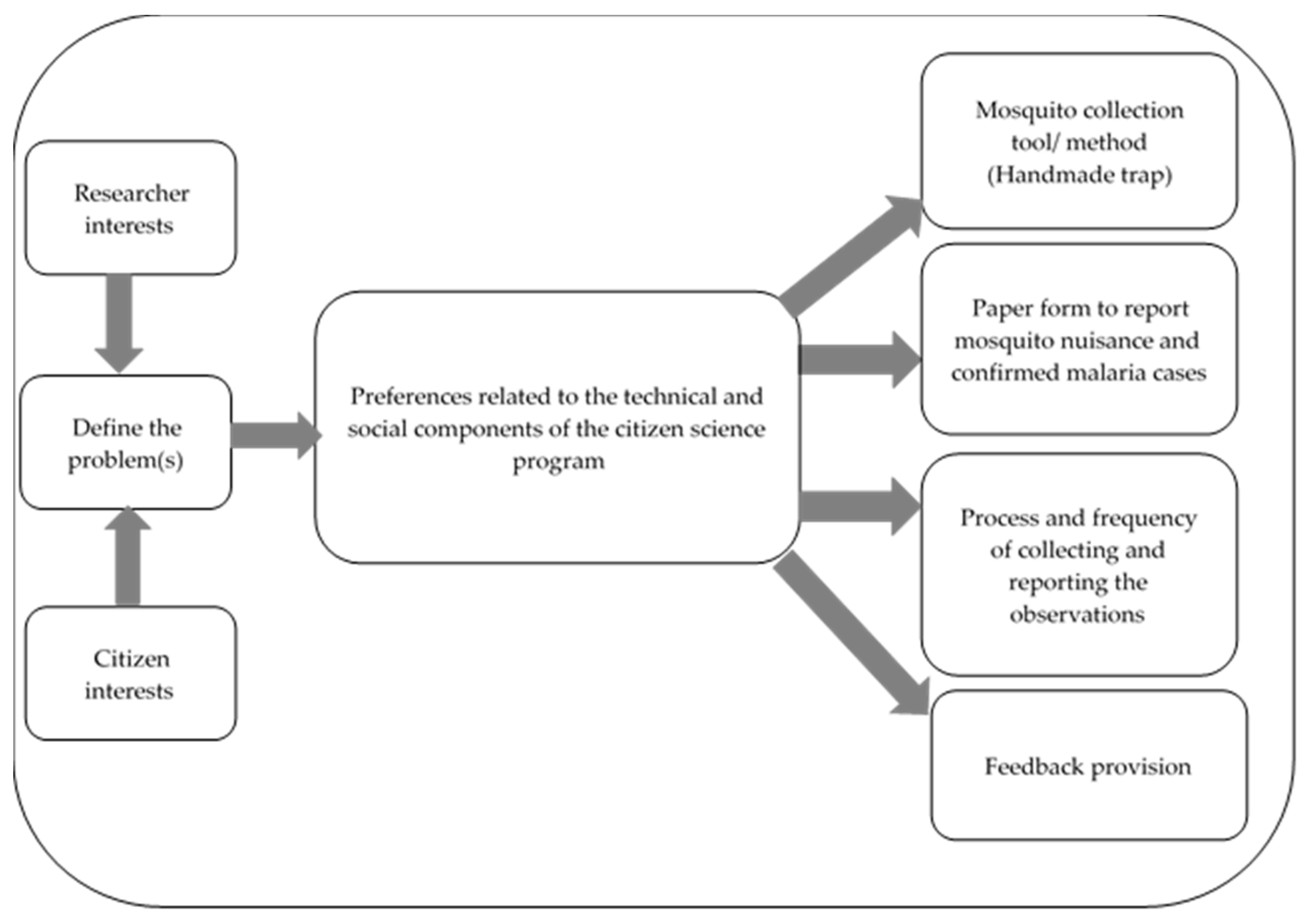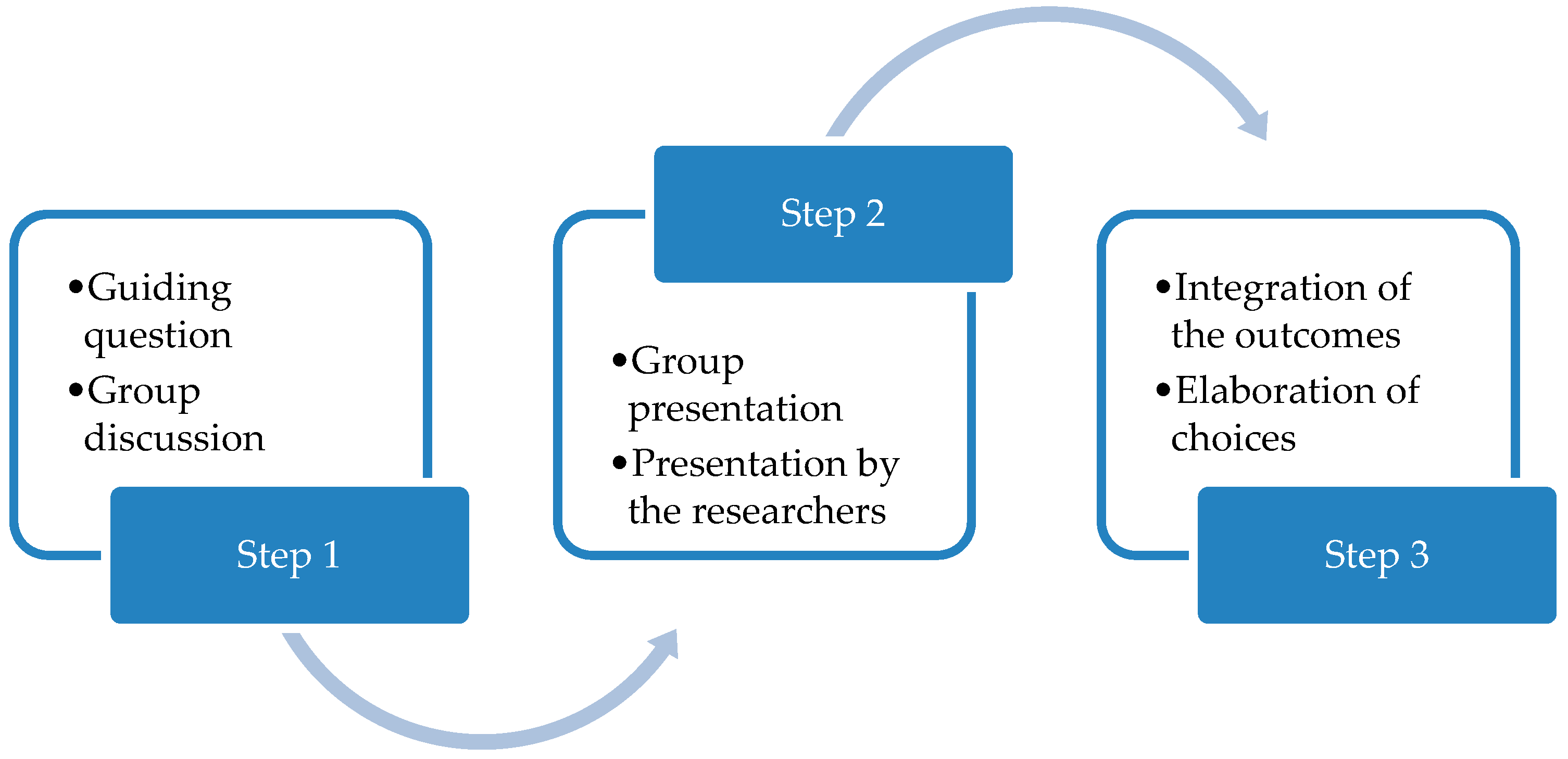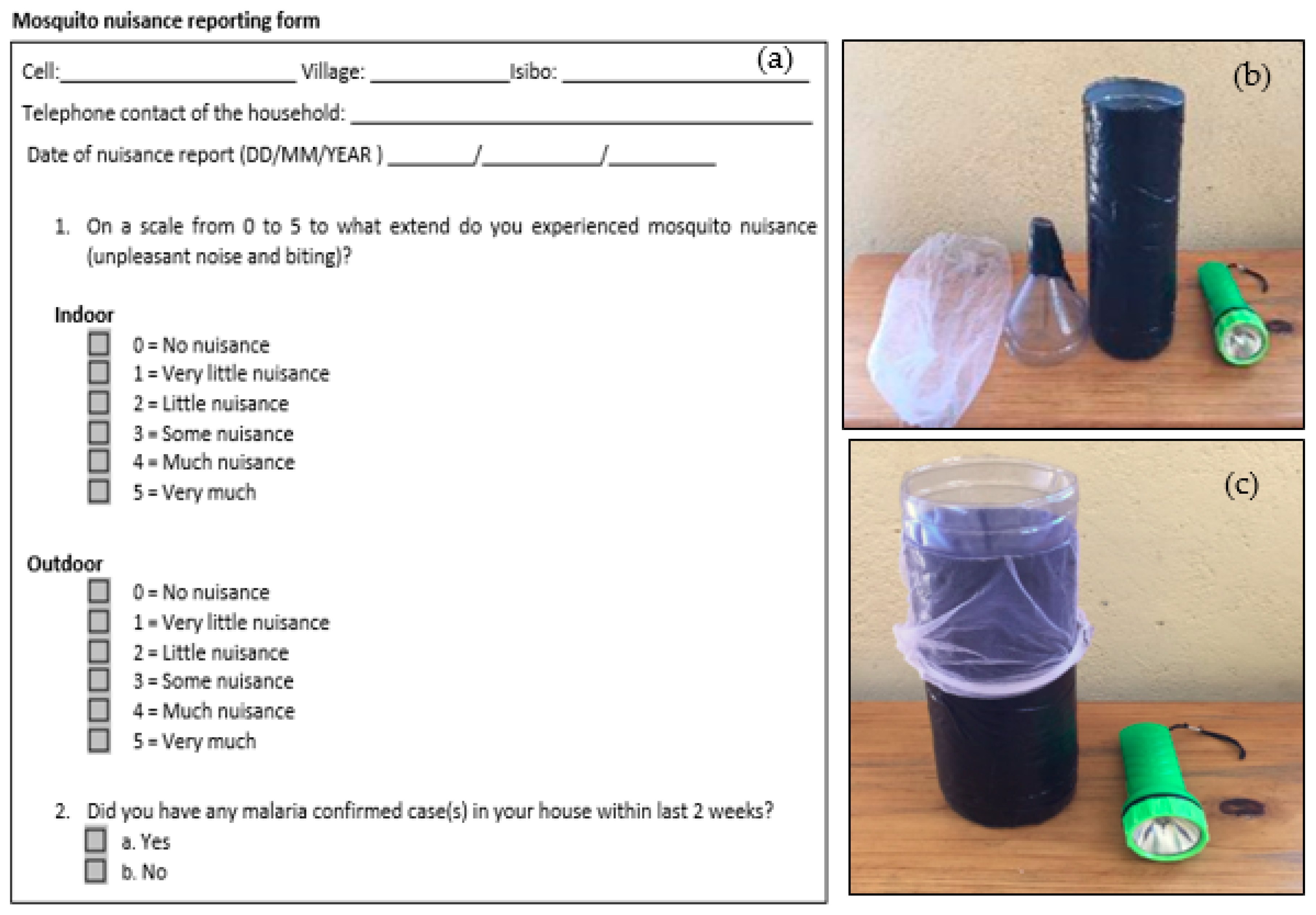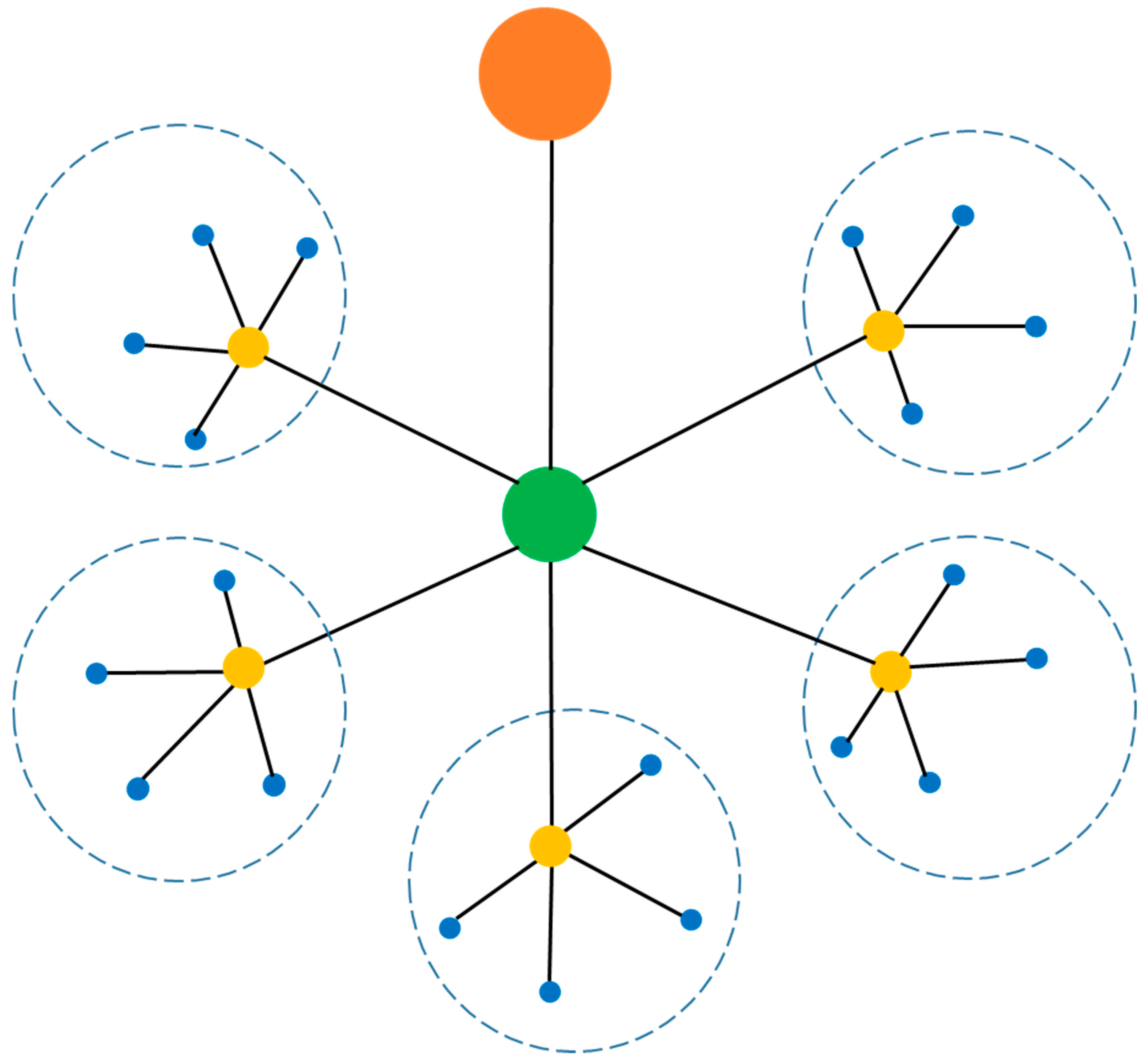Co-Designing a Citizen Science Program for Malaria Control in Rwanda
Abstract
1. Introduction
2. Conceptual Background
2.1. Citizen Science as a Tool for Mosquito Surveillance
2.2. Co-Designing a CSP
3. Methods
3.1. Study Area
3.2. Study Design, Population, and Sampling
3.3. Recruitment Process
3.4. Co-Design Processes
3.4.1. Pilot Workshop
3.4.2. Five Participatory Design Workshops
3.5. Data Analysis
3.6. Ethical Approval
4. Results
4.1. Pilot Workshop
4.1.1. Mosquito Nuisance Experienced
4.1.2. Willingness to Participate in Mosquito Collections
4.2. The Participatory Design Workshops
4.2.1. Characteristics of the Participants Who Attended the Five PDWs
4.2.2. Technical Component of the CSP
Technical Tool to Report Mosquito Nuisance and Confirmed Malaria Cases
Technical Tool for Collecting Mosquitoes
4.2.3. Social Component
Recruitment of Volunteers for The CSP and The Collection of The Observations
Strategies for Collecting and Reporting the Observations
Frequency of Collecting and Reporting Observations
Feedback Generation from the Reported Observations
5. Discussion
5.1. Involving Citizens in the Co-Design Process
5.2. Why Providing Feedback to Volunteers?
5.3. Study Limitations and Future Research
6. Conclusions
Author Contributions
Funding
Acknowledgments
Conflicts of Interest
References
- President’s Malaria Initiative. Rwanda Malaria Operational Plan FY. Available online: https://www.pmi.gov/docs/default-source/default-document-library/malaria-operational-plans/fy-2018/fy-2018-rwanda-malaria-operational-plan.pdf?sfvrsn=6 (accessed on 2 October 2019).
- Karema, C.; Aregawi, M.W.; Rukundo, A.; Kabayiza, A.; Mulindahabi, M.; Fall, I.S.; Gausi, K.; Williams, R.O.; Lynch, M.; Cibulskis, R.; et al. Trends in malaria cases, hospital admissions and deaths following scale-up of anti-malarial interventions, 2000–2010, Rwanda. Malar. J. 2012, 11, 236. [Google Scholar] [CrossRef]
- MOH. Revised National Malaria Contingency Plan 2016–2020; (Unpublished report); MOH: Kigali, Rwand, 2017. [Google Scholar]
- Rwanda Malaria Indicator Survey (RMIS) 2017. Available online: https://dhsprogram.com/pubs/pdf/MIS30/MIS30.pdf (accessed on 25 September 2019).
- Global vector control response 2017–2030. Available online: https://apps.who.int/iris/bitstream/handle/10665/259205/9789241512978 eng. pdf;jsessionid=818450DB7426D9B70BC0A7EC26E8E195?sequence=1 (accessed on 2 November 2019).
- World Malaria Report 2018. Available online: https://apps.who.int/iris/bitstream/handle/10665/275867/9789241565653-eng.pdf (accessed on 5 August 2019).
- Wu, T.P.; Tian, J.H.; Xue, R.-D.; Fang, Y.-L.; Zheng, A.H. Mosquito (Diptera: Culicidae) Habitat Surveillance by Android Mobile Devices in Guangzhou, China. Insects 2016, 7, 79. [Google Scholar] [CrossRef] [PubMed]
- President’s Malaria Initiative. Rwanda Malaria Operational Plan FY; 2019. Available online: https://www.pmi.gov/docs/default-source/default-document-library/malaria-operational-plans/fy19/fy-2019-rwanda-malaria-operational-plan.pdf?sfvrsn=3 (accessed on 2 November 2019).
- Hakizimana, E.; Karema, C.; Munyakanage, D.; Githure, J.; Mazarati, J.B.; Tongren, J.E.; Takken, W.; Binagwaho, A.; Koenraadt, C.J.M. Spatio-temporal distribution of mosquitoes and risk of malaria infection in Rwanda. Acta Trop. 2018, 182, 149–157. [Google Scholar] [CrossRef] [PubMed]
- Murindahabi, M.M.; Asingizwe, D.; Poortvliet, P.M.; van Vliet, A.J.H.; Hakizimana, E.; Mutesa, L.; Takken, W.; Koenraadt, C.J.M. A citizen science approach for malaria mosquito surveillance and control in Rwanda. NJAS Wagening. J. Life Sci. 2018, 86, 101–110. [Google Scholar] [CrossRef]
- Public Participation in Scientific Research: Defining the Field and Assessing Its Potential for Informal Science Education. Available online: https://files.eric.ed.gov/fulltext/ED519688.pdf (accessed on 5 August 2019).
- Shirk, J.L.; Ballard, H.L.; Wilderman, C.C.; Phillips, T.; Wiggins, A.; Jordan, R.; McCallie, E.; Minarchek, M.; Lewenstein, B.V.; Krasny, M.E. Public Participation in Scientific Research: A Framework for Deliberate Design. Ecol. Soc. 2012, 17, 29. [Google Scholar] [CrossRef]
- Ingabire, C.M.; Hakizimana, E.; Kateera, F.; Rulisa, A.; Van Den Borne, B.; Nieuwold, I.; Muvunyi, C.; Koenraadt, C.J.M.; Van Vugt, M.; Mutesa, L.; et al. Using an intervention mapping approach for planning, implementing and assessing a community-led project towards malaria elimination in the Eastern Province of Rwanda. Malar. J. 2016, 15, 594. [Google Scholar] [CrossRef]
- Rickard, G.D.; Dudovitz, N.R.; Wong, D.M.; Jen, C.H.; Osborn, D.R.; Fernandez, E.H.; Donkor, I.C. Closing the gap between insecticide treated net ownership and use for the prevention of malaria. Prog. Community Health Partnersh. Res. Educ. Action 2011, 5, 123–131. [Google Scholar] [CrossRef]
- Kampen, H.; Medlock, J.M.; Vaux, A.G.; Koenraadt, C.J.; van Vliet, A.J.; Bartumeus, F.; Bartumeus, F.; Oltra, A.; Sousa, C.A.; Chouin, S.; et al. Approaches to passive mosquito surveillance in the EU. Parasites Vectors 2015, 8, 9. [Google Scholar] [CrossRef]
- Vogels, C.B.F.; van de Peppel, L.J.J.; van Vliet, A.J.H.; Westenberg, M.; Ibanez-Justicia, A.; Stroo, A.; Buijs, J.A.; Visser, T.M.; Koenraadt, C.J.M. Winter Activity and Aboveground Hybridization Between the Two Biotypes of the West Nile Virus Vector Culex pipiens. Vector-Borne Zoonotic Dis. 2015, 15, 619–626. [Google Scholar] [CrossRef]
- Hecker, S.; Bonney, R.; Haklay, M.; Holker, F.; Hofer, H.; Goebel, C.; Gold, M.; Makuch, Z.; Ponti, M.; Richter, A.; et al. Innovation in Citizen Science—Perspectives on Science-Policy Advances. Citiz. Sci. Theory Pract. 2018, 3, 1. [Google Scholar] [CrossRef]
- Palmer, J.R.B.; Oltra, A.; Collantes, F.; Delgado, J.A.; Lucientes, J.; Delacour, S.; Bengoa, M.; Eritja, R.; Bartumeus, F. Citizen science provides a reliable and scalable tool to track disease-carrying mosquitoes. Nat. Commun. 2017, 8, 916. [Google Scholar] [CrossRef] [PubMed]
- Walther, D.; Kampen, H. The Citizen Science Project ‘Mueckenatlas’ Helps Monitor the Distribution and Spread of Invasive Mosquito Species in Germany. J. Med. Entomol. 2017, 54, 1790–1794. [Google Scholar] [CrossRef] [PubMed]
- NISR. The Fifth Integrated Household Living Conditions Survey EICV5. Available online: http://www.statistics.gov.rw/publication/eicv-5-rwanda-poverty-profile-report-201617 (accessed on 15 August 2019).
- Chaki, P.P.; Dongus, S.; Fillinger, U.; Kelly, A.; Killeen, G.F. Community-owned resource persons for malaria vector control: enabling factors and challenges in an operational programme in Dar es Salaam, United Republic of Tanzania. Hum. Resour. Health 2011, 9, 21. [Google Scholar] [CrossRef] [PubMed]
- Kiware, S.S.; Russell, T.L.; Mtema, Z.J.; Malishee, A.D.; Chaki, P.; Lwetoijera, D.; Chanda, J.; Chinula, D.; Majambere, S.; Gimnig, J.E.; et al. A generic schema and data collection forms applicable to diverse entomological studies of mosquitoes. Source Code Biol. Med. 2016, 11, 4. [Google Scholar] [CrossRef] [PubMed]
- Eritja, R.; Ruiz-Arrondo, I.; Delacour-Estrella, S.; Schaffner, F.; Alvarez-Chachero, J.; Bengoa, M.; Puig, M.A.; Melero-Alcibar, R.; Oltra, A.; Bartumeus, F. First detection of Aedes japonicus in Spain: an unexpected finding triggered by citizen science. Parasites Vectors 2019, 12, 53. [Google Scholar] [CrossRef] [PubMed]
- Asingizwe, D.; Poortvliet, P.M.; Koenraadt, C.J.M.; Van Vliet, A.J.H.; Murindahabi, M.M.; Ingabire, C.; Mutesa, L.; Feindt, P.H. Applying citizen science for malaria prevention: an integrated conceptual framework. NJAS-Wagening. J. Life Sci. 2018, 86, 111–122. [Google Scholar] [CrossRef]
- Jordan, R.C.; Sorensen, A.E.; Ladeau, S. Citizen Science as a Tool for Mosquito Control. J. Am. Mosq. Control. Assoc. 2017, 33, 241–245. [Google Scholar] [CrossRef]
- Bartumeus, F.; Guilherme, B.C.; Eritja, R.; Kelly, A.H.; Finda, M.; Lezaun, J.; Okumu, F.; Quinlan, M.M.; Thizy, D.C.; Toe, L.P.; et al. Sustainable innovation in vector control requires strong partnerships with communities. PLoS Negleted Trop. Dis. 2019, 13, e0007204. [Google Scholar] [CrossRef]
- Sica de Campos, A.; Hartley, S.; de Koning, C.; Lezaun, J.; Velho, L. Responsible Innovation and political accountability: Genetically modified mosquitoes in Brazil. J. Responsible Innov. 2017, 4, 5–23. [Google Scholar] [CrossRef]
- Asingizwe, D.; Poortvliet, P.M.; Koenraadt, C.J.M.; van Vliet, A.J.H.; Ingabire, C.M.; Mutesa, L.; Leeuwis, C. Role of individual perceptions in the consistent use of malaria preventive measures: mixed methods evidence from rural Rwanda. Malar. J. 2019, 18, 270. [Google Scholar] [CrossRef]
- Jordan, R.; Gray, S.; Sorensen, A.; Newman, G.; Mellor, D.; Newman, G.; Hmelo-Silver, C.; LaDeau, S.; Biehler, D.; Crall, A. Studying citizen science through adaptive management and learning feedbacks as mechanisms for improving conservation. Conserv. Biol. 2016, 30, 487–495. [Google Scholar] [CrossRef] [PubMed]
- Sanoff, H. Special issue on participatory design. Des. Stud. 2007, 28, 213–215. [Google Scholar] [CrossRef]
- Smallegange, R.C.; Schmied, W.H.; van Roey, K.J.; Verhulst, N.O.; Spitzen, J.; Mukabana, W.R.; Takken, W. Sugar-fermenting yeast as an organic source of carbon dioxide to attract the malaria mosquito Anopheles gambiae. Malar J. 2010, 9, 292. [Google Scholar] [CrossRef] [PubMed]
- Mahajan, S.; Kumar, P.; Pinto, J.A.; Riccetti, A.; Schaaf, K.; Camprodon, G.; Smari, V.; Passani, A.; Forino, G. A citizen science approach for enhancing public understanding of air pollution. Sustain. Cities Soc. 2019, 52, 101800. [Google Scholar] [CrossRef]
- Worthington, J.P.; Silvertown, J.; Cook, L.; Cameron, R.; Dodd, M.; Greenwood, R.M.; Mc Conway, K.; Skelton, P. Evolution MegaLab: a case study in citizen science methods. Methods Ecol. Evol. 2012, 3, 303–309. [Google Scholar] [CrossRef]
- Beza, E.; Reidsma, P.; Poortvliet, P.M.; Belay, M.M.; Bijen, B.S.; Kooistra, L. Exploring farmers’ intentions to adopt mobile Short Message Service (SMS) for citizen science in agriculture. Comput. Electron. Agric. 2018, 151, 295–310. [Google Scholar] [CrossRef]
- West, S.; Pateman, R. Recruiting and Retaining Participants in Citizen Science: What Can Be Learned from the Volunteering Literature? Citiz. Sci. Theory Pract. 2016, 1, 1–10. [Google Scholar] [CrossRef]
- Rambonnet, L.; Vink, S.C.; Land-Zandstra, A.M.; Bosker, T. Making citizen science count: Best practices and challenges of citizen science projects on plastics in aquatic environments. Mar. Pollut. Bull. 2019, 145, 271–277. [Google Scholar] [CrossRef]
- Nov, O.; Arazy, O.; Anderson, D. Scientists@Home: What Drives the Quantity and Quality of Online Citizen Science Participation? PLoS ONE 2014, 9, e90375. [Google Scholar] [CrossRef]
- Van der Wal, R.; Sharma, N.; Mellish, C.; Robinson, A.; Siddharthan, A. The role of automated feedback in training and retaining biological recorders for citizen science. Conserv. Biol. 2016, 30, 550–561. [Google Scholar] [CrossRef]
- Ryan, S.F.; Adamson, N.L.; Aktipis, A.; Andersen, L.K.; Austin, R.; Barnes, L.; Beasley, M.R.; Bedell, K.D.; Briggs, S.; Chapman, B.; et al. The role of citizen science in addressing grand challenges in food and agriculture research. Proc. R. Soc. 2018, 285, 891. [Google Scholar] [CrossRef] [PubMed]
- Leeuwis, C.; Cieslik, K.J.; Aarts, M.N.C.; Dewulf, A.R.P.J.; Ludwig, F.; Werners, S.E.; Struik, P.C. Reflections on the potential of virtual citizen science platforms to address collective action challenges: Lessons and implications for future research. NJAS-Wagening. J. Life Sci. 2018, 86, 146–157. [Google Scholar] [CrossRef]




| Village | Expected Participants | No. of Participants Attended PDWs | Male | Female |
|---|---|---|---|---|
| Frequency (%) | Frequency (%) | Frequency (%) | ||
| Busasamana | 45 | 17 (38%) | 10 (59%) | 7 (41%) |
| Kagasera | 45 | 45 (100%) | 12 (27%) | 33 (73%) |
| Kibaza | 45 | 33 (73%) | 17 (51%) | 16 (49%) |
| Kiyovu | 45 | 43 (95%) | 17 (40%) | 26 (60%) |
| Mubano | 45 | 47 (104%) | 24 (51%) | 23 (49%) |
| Total | 225 | 185 (82%) | 80 (43%) | 105 (57%) |
| Village | Groups | ||
|---|---|---|---|
| Men | Women | Youth | |
| Busasamana village | Once a month | ||
| Kagasera village | Once a month | Once in two weeks | Once a week |
| Kibaza village | Once a month | Once a month | |
| Kiyovu village | Once a month | Once a month | Once a month |
| Mubano village | Once a month | Once a month | Once in two weeks |
| Components | Preferences/Choices |
|---|---|
| Technical Design Component | |
| Reporting mosquito nuisance | -Write down the mosquito nuisance level indoor, outdoor, and in general on paper forms and this is done every last Wednesday of the month by the volunteer. -Weighing the costs of using a paper-based form and mobile phone, paper-based form does not cost much. Hence it was preferred for reporting mosquito nuisance. |
| Collecting mosquitoes | -Mosquitoes are caught with a handmade trap that consists of a plastic bottle filled with yeast and sugar, a torch, and this is done every last Wednesday of the month. -Provision of materials to collect mosquitoes (yeast, sugar, torch, and the trap). |
| Social component | |
| Volunteer recruitment | -Everybody that attended the participatory workshop was eligible to be a volunteer. Those who were willing to participate were invited to write their names on the provided sheet. |
| Who should collect what? | -Volunteers could choose whether to report mosquito nuisance only, collect mosquitoes only, or do both. |
| Reporting the information | -Volunteers selected the isibo representatives who are responsible for gathering the collected information and submit them to the research team. -Volunteers hand in the forms indicating the mosquito nuisance experienced and the mosquitoes caught to the isibo representatives during the monthly meeting that takes place in the last week of the month. The isibo representatives then have to submit the observations to the researchers at the health center where the researchers are based every last Friday of the month. |
| Frequency of collecting and reporting the information | -Once a month during the isibo meeting. |
| Feedback generation | -Once a month, researchers provide feedback to the isibo representative via SMS. He/she then communicates the feedback to the volunteers when volunteers collect the materials for the next round. Volunteers discuss the feedback and may take measures based on it. For example, if some malaria cases were reported, they discussed why those cases appeared and aimed to reduce the number of cases reported in the next round of reporting by a more consistent use of malaria control measures. |
© 2019 by the authors. Licensee MDPI, Basel, Switzerland. This article is an open access article distributed under the terms and conditions of the Creative Commons Attribution (CC BY) license (http://creativecommons.org/licenses/by/4.0/).
Share and Cite
Asingizwe, D.; Milumbu Murindahabi, M.; Koenraadt, C.J.M.; Poortvliet, P.M.; van Vliet, A.J.H.; Ingabire, C.M.; Hakizimana, E.; Mutesa, L.; Takken, W.; Leeuwis, C. Co-Designing a Citizen Science Program for Malaria Control in Rwanda. Sustainability 2019, 11, 7012. https://doi.org/10.3390/su11247012
Asingizwe D, Milumbu Murindahabi M, Koenraadt CJM, Poortvliet PM, van Vliet AJH, Ingabire CM, Hakizimana E, Mutesa L, Takken W, Leeuwis C. Co-Designing a Citizen Science Program for Malaria Control in Rwanda. Sustainability. 2019; 11(24):7012. https://doi.org/10.3390/su11247012
Chicago/Turabian StyleAsingizwe, Domina, Marilyn Milumbu Murindahabi, Constantianus J.M. Koenraadt, P. Marijn Poortvliet, Arnold J.H. van Vliet, Chantal M. Ingabire, Emmanuel Hakizimana, Leon Mutesa, Willem Takken, and Cees Leeuwis. 2019. "Co-Designing a Citizen Science Program for Malaria Control in Rwanda" Sustainability 11, no. 24: 7012. https://doi.org/10.3390/su11247012
APA StyleAsingizwe, D., Milumbu Murindahabi, M., Koenraadt, C. J. M., Poortvliet, P. M., van Vliet, A. J. H., Ingabire, C. M., Hakizimana, E., Mutesa, L., Takken, W., & Leeuwis, C. (2019). Co-Designing a Citizen Science Program for Malaria Control in Rwanda. Sustainability, 11(24), 7012. https://doi.org/10.3390/su11247012






